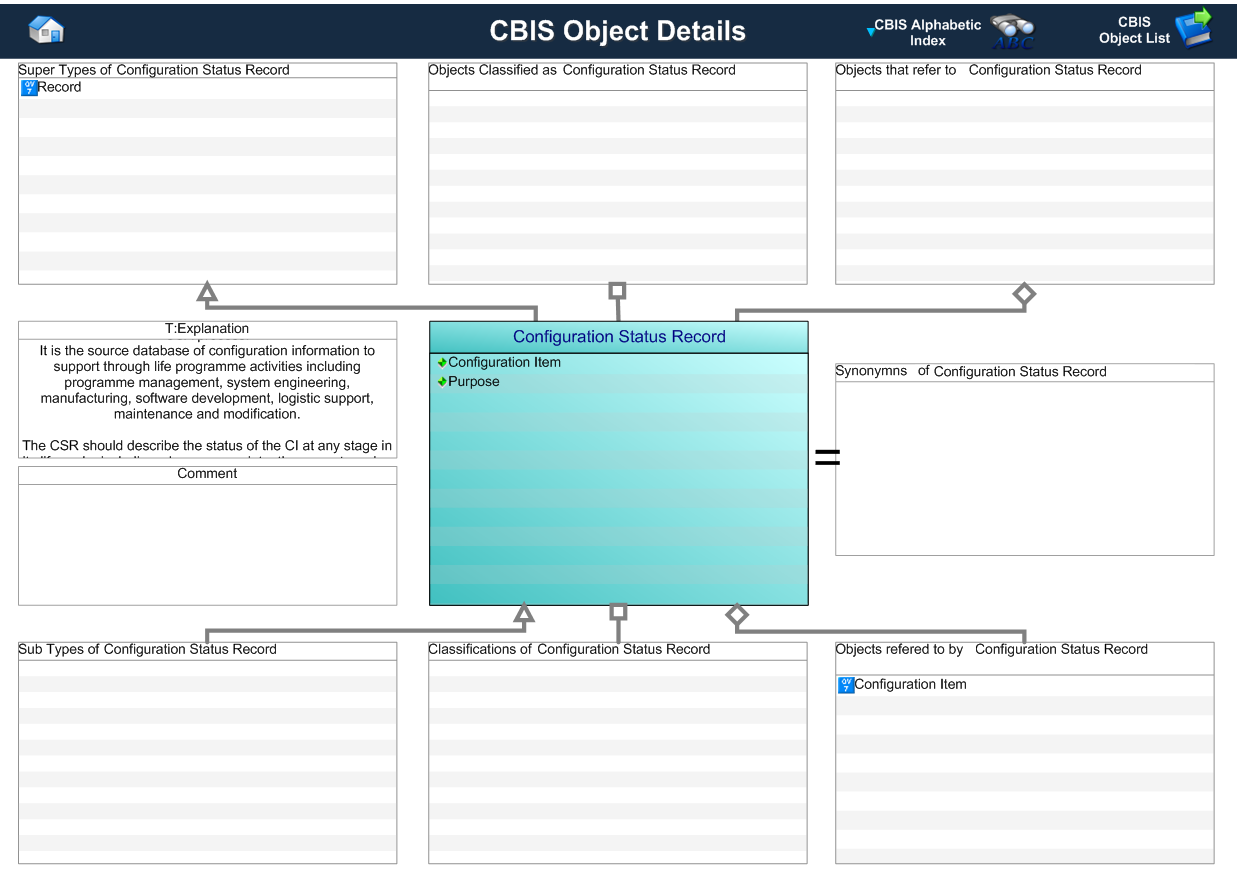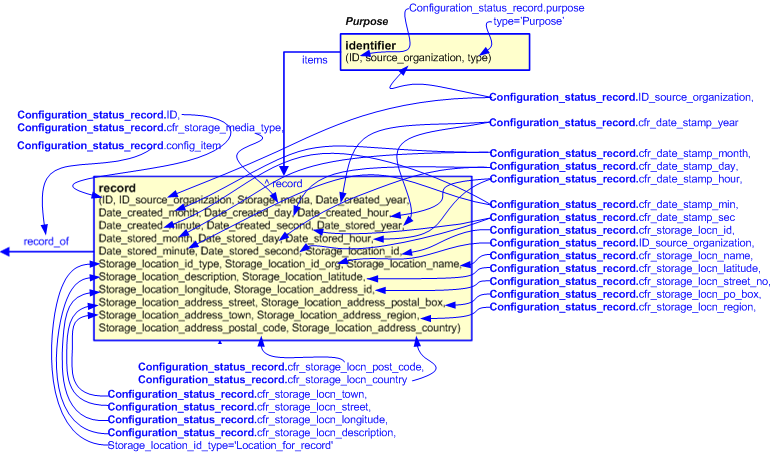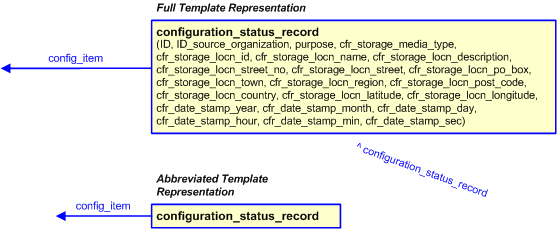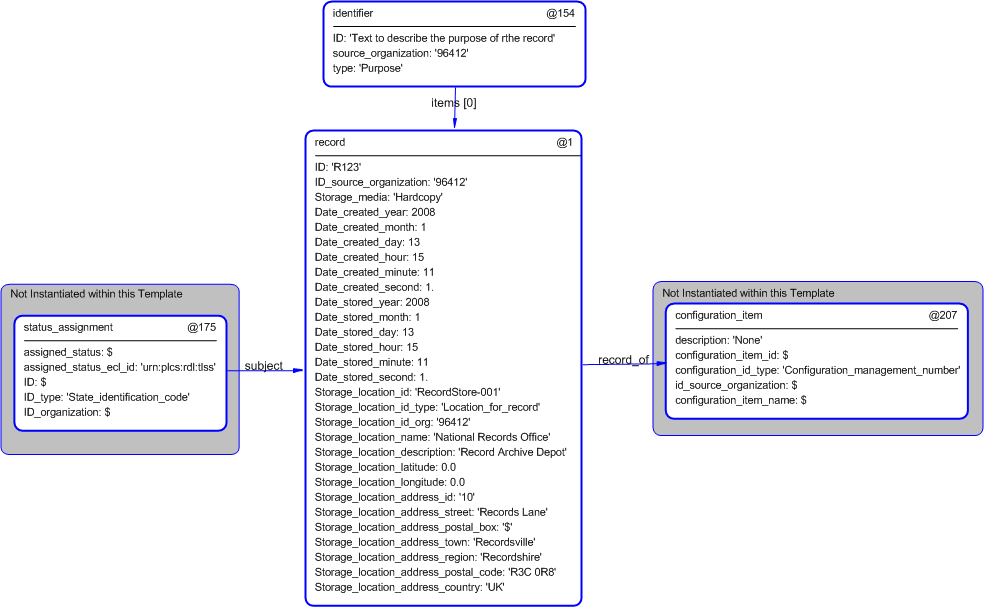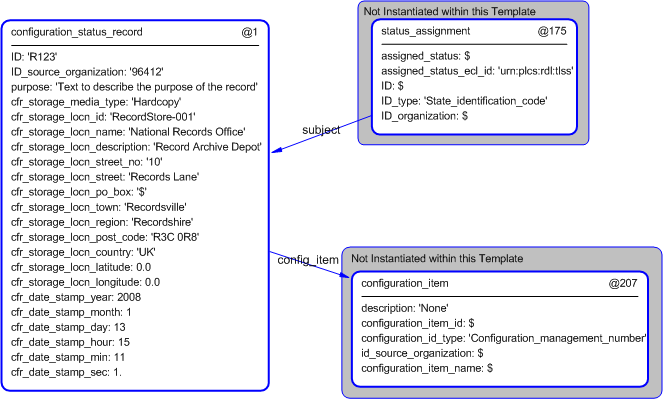Template:— configuration_status_record (conf_stat_rec)
Context:— UK_Defence |
Date: 2009/04/17 10:48:25
Revision: 1.3
|
This section specifies the template configuration_status_record.
NOTE
The template has been defined in the context of
UK_Defence.
Refer to the business context for details of related templates.
NOTE
An explanation of a template and the associated instantiation path is
provided in the
Template overview
section.
This template describes how to represent the record produced by the CSA process.
It is the source database of configuration information to support through life programme activities including programme management,
system engineering, manufacturing, software development, logistic support, maintenance and modification.
The Configuration Status Record should describe the status of the Configuration Item at any stage in its life cycle, including
where appropriate, the current version of each Configuration Item.
NOTE
This template is based upon the 'record' business object and specializes it to represent the configuration status record.
However, the 'status' is provided through a characterization using the 'status assignment' business object.
This template describes how to represent a configuration status record.
This information object represents the record of the configuration for an applicable item.
Figure 1 — Graphical Representation for Business Object Configuration Status Record
|
Attribute name
|
Attribute description
|
Attribute type
|
Optionality
|
| Configuration Item |
The reference to the Configuration Item for which the Configuration Status Record was made. |
relationship to configuration_item (relationship to the configuration_item UK_Defence DEX business template)
|
Mandatory(1:?)
|
| Purpose |
The purpose for which the Configuration Status Record was created. |
Intrinsic |
Mandatory |
Table 1 — Configuration Status Record attribute details
Note that this business object (configuration status record) has a super-type (record) which means that all attributes are
'inherited' and as such are *in addition* to those shown specifically below for this object.
The EXPRESS-G diagram in
Figure
2
shows the templates and EXPRESS entities that are required
to represent the template
"configuration_status_record".
The text highlighted in blue shows the template parameters.
Figure 2 — An EXPRESS-G representation of the Information model for configuration_status_record
The graphic for the template to be used in other EXPRESS-G diagrams
is shown in Figure
3
below.
Figure 3 — The graphical representation of the configuration_status_record template
The following input parameters are defined for this template:
The identifier of the record.
The identifier of the organization responsible for identifying the record.
purpose (Default=This describes the purpose of the record,Type='STRING')
The identifier of the record.
The name of the class used to classify the
Hardcopy that constitutes the record
and thereby indicate the storage medium of that record.
The following classes and their sub-classes can be used:
The configuration management breakdown to which the record is assigned.
The following reference parameters are defined for this template:
Allow the
Hardcopy
entity instantiated in this path to be referenced when this template is used.
Note: The
Hardcopy
entity can be referenced in a template path by:
%^target = $configuration_status_record.configuration_status_record%
where
target
is the parameter to which the
Hardcopy
is bound.
The instantiation path shown below specifies the entities that are to be
instantiated by the template.
A description of templates and the syntax for the instantiation path is
provided in the
Templates Help/Information section.
-- A Configuration Status Record is a type of Record. Therefore, we create the record first, then apply new attributes to
it. /
record(
record_of=@config_item,
ID=@ID,
ID_source_organization=@ID_source_organization,
Storage_media=@cfr_storage_media_type,
Date_created=@cfr_date_stamp,
Date_stored=@cfr_date_stamp)/
-- note that we assume the storage date/time is the same as that for the date_stamp for this template. %^configuration_status_record = $record.record%
-- Cannot provide the purpose of the csr using descriptor -- /assigning_descriptor(descr=@purpose, class_name='Purpose', ecl_id='urn:plcs:rdl:uk_defence', is_assigned_to=^configuration_status_record)/
-- thus we must use Identifier instead. /
identifier(
ID=@purpose,
source_organization=@ID_source_organization,
type='Purpose',
items=^configuration_status_record)/
-- If it doesn't make sense to have a config status record w/o the status, then we could use the following to embed the call
to status_assignment. -- Note - it will need some new input params to match! -- /status_assignment(assigned_status=@status, assigned_status_ecl_id='urn:plcs:rdl:uk_defence', ID=@status_id, ID_type='Configuration_state_id_code',
-- ID_organization=@ID_source_organization, subject=^configuration_status_record, type=@status_type, type_ecl_id='urn:plcs:rdl:uk_defence')/
The instance diagram in Figure
4
shows an example of the EXPRESS entities and templates that are instantiated by the template:
/configuration_status_record(ID='R123', ID_source_organization='96214', purpose='Text to describe the purpose of the record', cfr_storage_media_type='Hardcopy', config_item='@207', cfr_storage_locn_id='RecordStore-001', cfr_storage_locn_name='National Records Office', cfr_storage_locn_description='Record Archive Depot', cfr_storage_locn_street_no='10', cfr_storage_locn_street='Records Lane', cfr_storage_locn_po_box='', cfr_storage_locn_town='Recordsville', cfr_storage_locn_region='Recordshire', cfr_storage_locn_post_code='R3C 0R8', cfr_storage_locn_country='UK', cfr_storage_locn_latitude='', cfr_storage_locn_longitude='', cfr_date_stamp_year='2008', cfr_date_stamp_month='1', cfr_date_stamp_day='13', cfr_date_stamp_hour='15', cfr_date_stamp_min='11', cfr_date_stamp_second='1')/
(an illustration of the consolidated configuration_status_record template is shown in
Figure
5 below.)
Figure 4 — Entities instantiated by configuration_status_record template
The instance diagram in
Figure
5
shows the graphic symbol for the template that is to be
used in other instance diagrams. The example template is:
/configuration_status_record(ID='R123', ID_source_organization='96214', purpose='Text to describe the purpose of the record', cfr_storage_media_type='Hardcopy', config_item='@207', cfr_storage_locn_id='RecordStore-001', cfr_storage_locn_name='National Records Office', cfr_storage_locn_description='Record Archive Depot', cfr_storage_locn_street_no='10', cfr_storage_locn_street='Records Lane', cfr_storage_locn_po_box='', cfr_storage_locn_town='Recordsville', cfr_storage_locn_region='Recordshire', cfr_storage_locn_post_code='R3C 0R8', cfr_storage_locn_country='UK', cfr_storage_locn_latitude='', cfr_storage_locn_longitude='', cfr_date_stamp_year='2008', cfr_date_stamp_month='1', cfr_date_stamp_day='13', cfr_date_stamp_hour='15', cfr_date_stamp_min='11', cfr_date_stamp_second='1')/
Figure 5 — Instantiation of configuration_status_record template
Characterizations
No common characterizations of the template
configuration_status_record
have been identified. However, the ISO 10303-239 EXPRESS model
may enable other assignments to the entities instantiated by the template.
